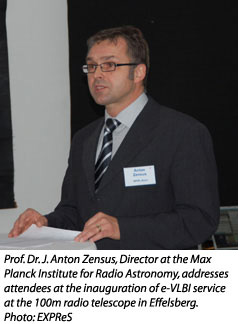News / Press Releases
Printer-friendly versionEffelsberg telescope inaugurated as member of the e-VLBI network
 DWINGELOO, The Netherlands (21 November 2008) - The Max Planck Institute for Radioastronomy (MPIfR) and other members of the Express Production Real-time e-VLBI Service (EXPReS) project celebrated Wednesday the beginning of e-VLBI service at the 100m Effelsberg radio telescope.
DWINGELOO, The Netherlands (21 November 2008) - The Max Planck Institute for Radioastronomy (MPIfR) and other members of the Express Production Real-time e-VLBI Service (EXPReS) project celebrated Wednesday the beginning of e-VLBI service at the 100m Effelsberg radio telescope.
The telescope was connected by a 35km dedicated high-speed fibre data link to Bonn earlier this year, allowing it to participate in electronic, real-time Very Long Baseline Interferometry observations (e-VLBI).
e-VLBI is a technique by which remotely located radio telescopes simultaneously observe the same region of sky, and data from each telescope is sampled and streamed to a central data processor via high-speed communication networks. This processor, a purpose-built supercomputer, decodes, aligns and correlates the data in real-time for every possible telescope combination and can generate images of cosmic radio sources with up to a hundred times better resolution than images from the best optical telescopes.
 "The ability to send data electronically and correlate it in real-time allows astronomers to receive their data within hours of conducting an observation, rather than weeks later via the traditional VLBI method of recording data onto disks and shipping it to the correlator," explains Dr. Huib Jan van Langevelde, Director of the Joint Institute for VLBI in Europe (JIVE), which developed and maintains the correlator for the European VLBI Network (EVN). He adds, "If a transient event such as a supernovae or gamma-ray burst is detected, the astronomer can respond quickly with a follow-on 'Target of Opportunity' (ToO) observation." In fact, the observing time reserved for the demonstration during the dedication was assigned at short notice to astronomical observations of a flaring black-hole candidate source.
"The ability to send data electronically and correlate it in real-time allows astronomers to receive their data within hours of conducting an observation, rather than weeks later via the traditional VLBI method of recording data onto disks and shipping it to the correlator," explains Dr. Huib Jan van Langevelde, Director of the Joint Institute for VLBI in Europe (JIVE), which developed and maintains the correlator for the European VLBI Network (EVN). He adds, "If a transient event such as a supernovae or gamma-ray burst is detected, the astronomer can respond quickly with a follow-on 'Target of Opportunity' (ToO) observation." In fact, the observing time reserved for the demonstration during the dedication was assigned at short notice to astronomical observations of a flaring black-hole candidate source.
Wednesday's inauguration marks the connection of the largest and most sensitive single dish in the EVN. The addition of the Effelsberg telescope nearly doubles the sensitivity of the EVN's e-VLBI capabilities, allowing it to detect the faintest cosmological sources. Already since April, the Effelsberg telescope has participated in multiple e-VLBI scientific observations.
"The completion of the high-speed fibre optic link is a remarkable achievement and will enable the EVN to conduct e-VLBI experiments of a wide range of astrophysical objects," says Prof. Dr. J. Anton Zensus, Director at MPIfR. "In particular we hope to be able to study objects that show sudden variation in a faint central region where we suspect the presence of massive block holes."
The inaugural event included comments by Zensus, Langevelde and Mr. Jean-Luc Dorel, Programme Officer with the European Commission's Information Society and Media Directorate General (DG-INFSO). Attendees were also treated to an e-VLBI demonstration featuring the live ToO observation and a tour of the telescope.
# # #
About EXPReS
Express Production Real-time e-VLBI Service (EXPReS, www.expres-eu.org) is a three-year project funded by the European Commission with the objective of creating a real-time distributed astronomical instrument of intercontinental dimensions. This electronic Very Long Baseline Interferometer (e-VLBI) is achieved using high-speed communication networks and connecting together some of the largest and most sensitive radio telescopes on the planet. EXPReS is a collaboration of 19 radio astronomy institutes and national research networks in 14 countries and is coordinated by the Joint Institute for VLBI in Europe (JIVE). EXPReS is an Integrated Infrastructure Initiative (I3), funded under the European Commissionís Sixth Framework Programme (FP6), contract number 026642.
About JIVE
The Joint Institute for VLBI in Europe (JIVE, www.jive.nl) is a scientific foundation with a mandate to support the operations of the European VLBI Network (EVN). For this purpose it maintains, operates and develops the MKIV EVN Data Processor, a powerful supercomputer that combines the signals from radio telescopes located across the planet. Through this technique, called Very Long Baseline Interferometry (VLBI), astronomers can make detailed images of cosmic radio sources, providing astronomers with the clearest, highest resolution view of some of the most distant and energetic objects in the Universe.
Contact:
Huib Jan van Langevelde, Director
Joint Institute for VLBI in Europe
+31 521 596 500
langevelde@jive.nl
www.jive.nl
Kristine Yun, EXPReS Public Outreach Officer
Joint Institute for VLBI in Europe
+31 521 596 500
kyun@jive.nl
www.expres-eu.org